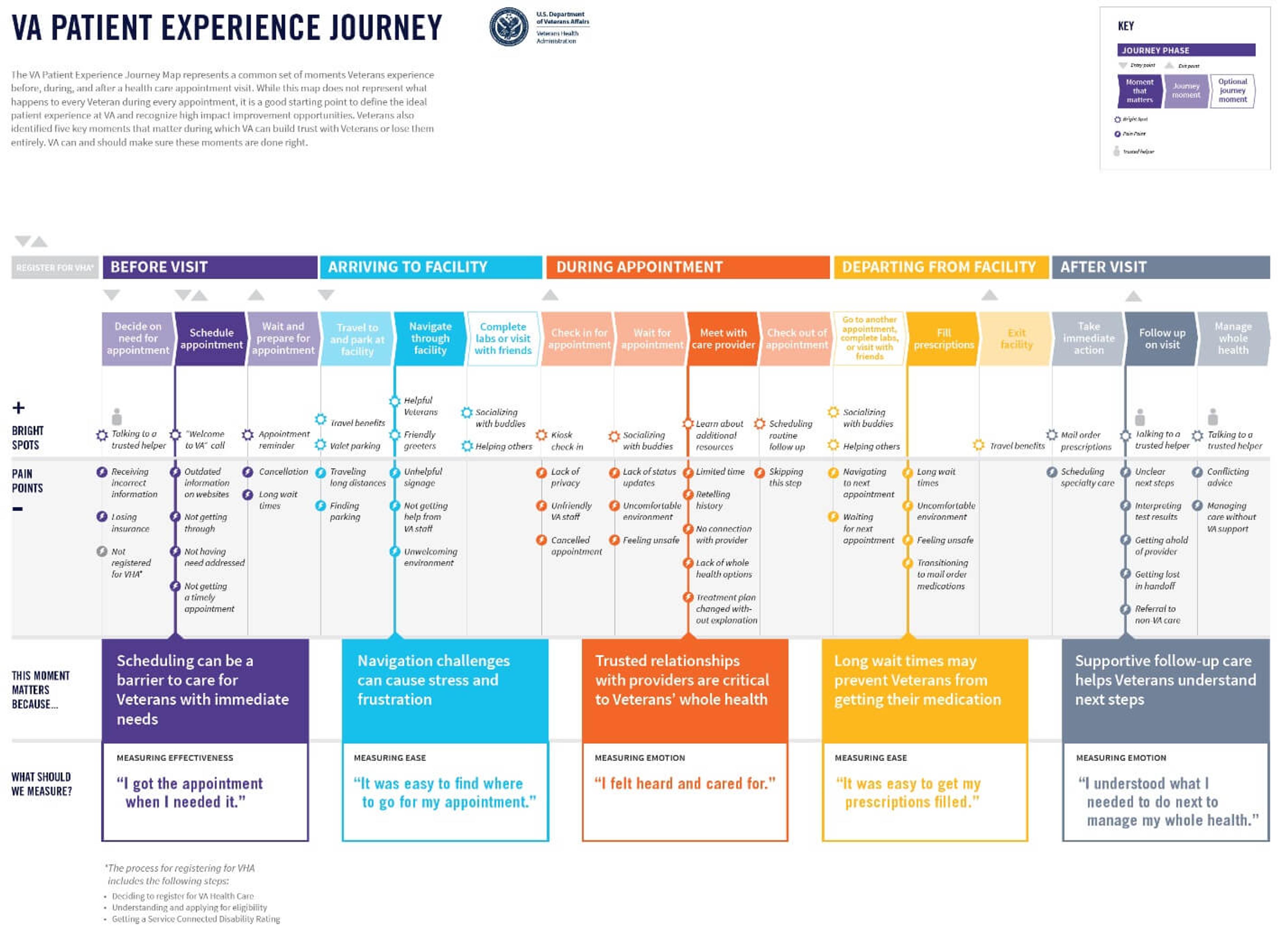blog
The 1-2-3 Guide to Patient Journey Mapping [Template Inside]
![The 1-2-3 Guide to Patient Journey Mapping [Template Inside]](/_next/image?url=%2F_next%2Fstatic%2Fmedia%2Farticle-hero-circle.f29028dc.png&w=3840&q=75&dpl=dpl_9wri8cUghejrdTfKejRE2tNvHiKk)
SECTIONS
Patient journeys in today’s healthcare landscape are complex, spanning a number of platforms, systems, touchpoints, and interactions. As patients engage with healthcare providers through diverse channels, both digital and physical, the need for a structured and comprehensive approach to managing the patient journeys is evident. Patient journey mapping is the solution.
Patient journey mapping creates a high-level and holistic view of the patient journey that empowers healthcare providers to make the most informed and impactful decisions possible about how to enhance operations and care.
In this guide, we’ll walk step-by-step through the process of creating and implementing a patient journey map that drives better performance results and patient outcomes for your healthcare organization.
Key Takeaways:
- Patient journey mapping is crucial for understanding and enhancing the patient experience.
- Patient journey mapping leads to improved patient satisfaction, better clinical outcomes, and increased operational efficiency.
- Developing a patient journey map requires clear objectives, a cross-functional team, and data-driven approaches to gaining insight.
- Improvement strategies should be developed for each critical moment and touchpoint, with changes implemented and continuously monitored for effectiveness over time.
What is Patient Journey Mapping and Why Is It Important?
Patient journey mapping is the process of creating a detailed visualization of a patient’s healthcare journey, from initial contact through treatment and follow-up care, identifying every touchpoint along the way. This methodical approach helps healthcare providers see the care process from the patient perspective, including the highs, lows, and gaps in the patient experience.
The example below is from the U.S. Department of Veteran Affairs, and shows how intricate and complex the patient journey is once it’s mapped completely. This drives home the importance of documenting the journey visually in order to see it in a holistic way.

Image Source
When done effectively, patient journey mapping is a valuable tool driving more seamless, integrated, and patient-centered care. Journey mapping also helps healthcare organizations make informed decisions about where to allocate resources, how to streamline operations, and ways to personalize care to meet the unique needs of each patient.
In the end, the benefits of patient journey mapping are threefold:
- Improved Patient Satisfaction: Enhances the overall patient experience by addressing specific needs and preferences, leading to higher satisfaction rates.
- Better Clinical Outcomes: Identifies opportunities for early intervention and personalized care plans, contributing to improved health results.
- Increased Operational Efficiency: Streamlines healthcare processes by pinpointing inefficiencies and redundancies, leading to more effective use of resources.
It leads to 360-degree improvements that enhance clinical, administrative, and operational aspects of both the healthcare system and the patient experience. In the next section, we’ll walk through the steps you can take to develop a patient journey map for your organization.
Your Step-by-Step Patient Journey Mapping Template
1. Identify The Goals and Scope of Your Map
Begin by developing a clear vision of what you aim to achieve through patient journey mapping. Whether it’s to enhance patient satisfaction, streamline healthcare delivery, or identify gaps in service, setting specific objectives will direct your mapping efforts. During this step, you should also determine the scope of your map (i.e. whether it focuses on a particular service line or the entire healthcare experience).
2. Gather a Cross-Functional Team
Assemble a team that represents a broad spectrum of roles within your organization, including clinicians, administrative staff, IT professionals, and customer service representatives. Diverse perspectives ensure a holistic view of the patient journey, capturing insights from every facet of patient interaction.
3. Map the Patient Touchpoints
Systematically list every interaction point between the patient and your healthcare system. This includes digital touchpoints like website visits, appointment scheduling portals, and social media interactions, as well as physical touchpoints like clinic visits, phone calls, and direct mail communication. Mapping these touchpoints requires a detailed understanding of the patient’s path through your system, from initial awareness through treatment and follow-up care.
4. Collect and Analyze Data
Leverage diverse data sources to understand patient experiences at each touchpoint. Collect patient feedback through channels like surveys, interviews, and comment cards. Analyze staff insights and review operational data. Look for patterns in behavior and satisfaction levels, and identify bottlenecks or pain points in the patient journey.
Having a centralized data management platform in place is crucial for this step—it provides a central repository for the data you collect as part of your patient journey mapping exercise, while also giving you seamless access to historical data in one location.
5. Visualize the Journey
Develop a visual representation of the patient journey. Use flowcharts, storyboards, or diagrams to depict the sequence of touchpoints and the patient’s experience at each stage. This visualization should be from the patient’s perspective, highlighting critical interactions, emotions, and decision points.
Tools like customer journey mapping software can facilitate this process, but even simple graphical tools or whiteboards can be effective.
6. Identify Moments of Truth
Highlight key moments in the journey that significantly impact the patient’s perception of care—things like first contact, diagnosis communication, wait times, and billing support. These are opportunities to make a lasting impression on the patient, and identifying them allows your team to prioritize areas for immediate improvement or innovation.
7. Develop Improvement Strategies
For each critical moment and touchpoint, evaluate what’s working effectively as well as areas for potential improvements. Call out specific gaps and pain points that may exist for the patient at every stage on your journey map. Then, brainstorm how to resolve them.
This may happen by introducing new technologies, optimizing existing processes, providing additional training for your staff, enhancing communication strategies, and more.
8. Implement Changes
Prioritize the identified improvements based on their potential impact and feasibility. Create a detailed implementation plan, assigning clear responsibilities and deadlines. Ensure there is a mechanism for tracking progress and measuring the impact of these changes on the patient experience and other goals and objectives you set at the start of the process.
9. Monitor and Adjust
Establish a continuous feedback loop to monitor the effectiveness of implemented changes. Use patient feedback, staff input, and performance metrics to assess progress. Be prepared to make iterative adjustments to your strategies based on this feedback, fostering a culture of continuous improvement.
Putting it All Together
Embarking on patient journey mapping is more than a strategic exercise—it’s a commitment to elevating the standard of care through a deep understanding of the patient’s experience. It represents a pivotal shift toward a more empathetic, patient-centric approach in healthcare, where decisions are informed by the nuanced needs and experiences of those we serve.
Gaine’s Coperor platform is a scalable, ecosystem-wide master data management solution designed for the unique challenges of the healthcare and life sciences industries. It creates a single source of data truth within an organization that makes initiatives like journey mapping possible. Learn more here or start your real-time Coperer demo today.
